



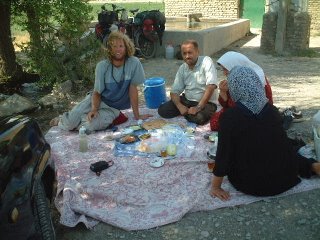
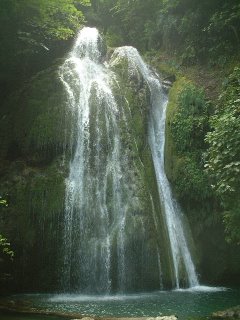


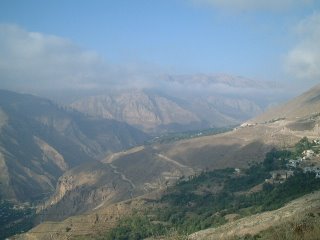

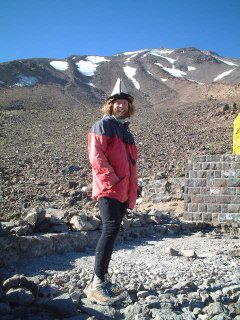


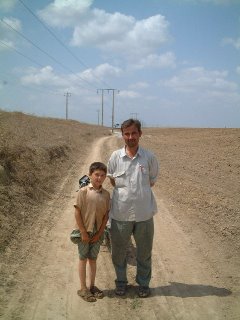

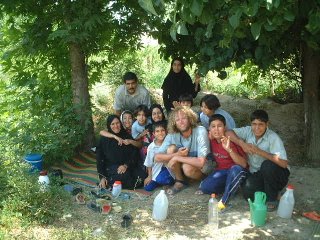






Cairo, August 22nd
End of journey: Teheran, 6500 km from Urumqi, 10,000 km from Xian
Hello everyone:
I'm sitting in the relative peace and quiet of Maadi, the leafy southern enclave of Cairo which is where many expats and rich Cairenes live and which will be home base for me for the next couple of years. It seems like forever since I rode into Teheran to end my bike trip, but it was really just 6 days ago.
I can't remember what I wrote from Mashhad about Iran, so I'm going to start from the beginning, from the Turkmen-Iranian border at Sarakhs. It was like a rebirth into colour and life and energy after the soporific lethargy of the ex-Soviet states. There was bustle on the streets, and hundreds of shops did a roaring trade along every main street. I rode from Sarakhs to Mashhad in two long, hot days. The road climbed slowly from the lowland desert landscapes of Turkmenistan to the plateau which dominates most of Iran. Along the way I passed a couple of old caravansarais (fortified hotels for camel caravans) from the Seljuk era (11th and 12th centuries AD). It was good to feel connected with the old Silk road merchants who once plied this route. The road was in good shape but quite busy, meaning that I had to keep my wits about me rather than absent-mindedly pedalling while contemplating the landscape.
The first night I spent in a small village perched at the top of a small pass. I hadn't been in the Islamic Republic of Iran 24 hours before I was being offered contraband wine by the owners of a cafe. I had a few sips, but it was truly awful. As Robert Byron observed 65 years ago while travelling through Iran, "Persians drink more for the sin of it than out of real enjoyment."
The next day I continued into the vast urban sprawl of Mashhad. It's the premier pilgrimage centre of the country, Iran's answer to Mecca and Najf, and is full of Shi'ite pilgrims from all over the Arab and Muslim world, particularly Saudi Arabia and Iraq. They come to revere the tomb of Imam Reza, the eighth leader of the Shi'ite faith. The Shi'ites, supporters of the idea that Islam should be led by direct descendants of Mohammed, have been led by 12 Imams. The following list of the Imams' fates provides a measure of how badly they've been persecuted by the Sunni mainstream.
1. Stabbed to death by assassins
2. Poisoned
3. Killed in battle against Sunnis
4. Poisoned
5. Poisoned
6. Poisoned
7. Tortured to death
8. Poisoned
9. Poisoned
10. Poisoned
11. Poisoned
12. Vanished into thin air.
Not an encouraging list if you're a would-be imam, is it?
After 3 days in Mashhad, arranging airplane tickets and resting up, I set off for Teheran. I made a mistake almost immediately. There are two routes to Teheran, one running south of the mountains along the edge of a vast desert, and the other running north of the mountains and then along the Caspian Sea coast. I chose the latter because every Iranian I talked to raved about the beauty of the Caspian coast. As soon as I left Mashhad, though, I realized that because everyone in Iran believes this, this particular road is incredibly busy all summer with Iranian holidaymakers. White Paykan cars (the domestically-made workhorse of Iran), each with about 9 family members shoehorned into them, fill the road bumper to bumper all day, while faster KIA and Peugeot cars and smoke-belching trucks try to overtake them. The noise of whining engines is overwhelming in itself, but it is merely the accompaniment to a cacophony of horns. Apparently, Iranian drivers use their horns to signal one of four messages:
1. You're driving too slow.
2. You're driving too fast.
3. My car has a horn.
4. Ya Mohammed! Ya Ali! There is a foreigner on a bicycle!
In the case of message 4, the horn signal is a constant series of blasts continuing until the foreigner turns, makes eye contact and waves. The noise was nerve-shattering, but even more annoying was the constant stream of cars and motorcycles which would ride up beside me and try to have conversations while driving. I tried to be polite, but as the conversations were all in Farsi, they tended to be one-sided and unsatisfying. If more than one motorcycle slowed down to talk, then I would instantly be the centre of a cloud of motorcycles, all buzzing around me and trying to talk while accidentally running me off the road and causing even more traffic chaos than usual. The noise, the heat, the constant attention and the vast amounts of garbage strewn along the roadside made for a less-than-ideal cycling experience. I gritted my teeth, kept my head down and continued cycling.
Leaving Mashhad, I passed a few historical sites: the tomb of the poet Firdausi (Iran's answer to Dante), a tomb popularly believed to be that of the great Caliph Harun al-Rashid (but he's almost certainly buried in Mashhad at the feet of Imam Reza) and a beautiful tower tomb in the village of Radkan which I spotted from the highway and rode half an hour out of my way to inspect.
I spent the night camped inside an abandoned building and set off the next morning into a howling headwind. I fought my way gently uphill to Quchan, where I got taken home for lunch by a genial schoolteacher. After a generous feast, we went out in his pickup truck to his country garden where he grows peaches, apples and grapes. En route we detoured into the Kopet Dagh mountains to see pretty Cubist villages populated by Kurds and Turks and Baluchi herdsmen. We sipped a quite reasonable white wine which he produces clandestinely and I ended up spending the night at his house, sleeping soundly after another sumptuous feast. By this time I had noticed that while Iran's restaurants are overpriced and serve unappetizing, dull kebabs and rice, whenever I ate at somebody's house, there were great dishes to be had. I'm not sure why this is; one suggestion that I heard is that because women don't cook in restaurants, there's not much good food to be had there.
The following day was the biggest ride of the entire trip. I didn't get a particularly early start (8 am) but as soon as I hit the highway, I realized that I had a brisk tailwind behind me and a gentle downhill ahead. I raced along at almost 30 km/h for long stretches, and took less than 4 hours to do the first 100 kilometres. Eventually the road levelled off and then began to climb over a mountain range, slowing progress, but it was still only mid-afternoon. I climbed through desert hills and then up into a huge area of vineyards; I wonder how much black market wine comes from this area. Eventually, after 180 km of riding, I quit and got a hotel room to collapse into.
After that day's exertions, I had a series of shorter days caused by headwinds or my own stupidity. The next day I rode a shorter day up onto a slightly desolate plateau reminiscent of the Pamirs, and spent the night sleeping in the ruins of another Seljuk caravansarai, soaking up the historical atmosphere and the ghosts of past travellers. Somehow the collapsing, half-buried stone arches seemed so much more appropriate for a Silk Road ride than the previous day's concrete block hotel.
I then rode down onto the Caspian Sea plain, dropping all day through a gorgeous hardwood forest reminiscent of the Japanese mountains. The edge of the forest was very sharp; within two kilometres I had moved from desert to near rainforest. The forest was full of picnicking Iranians who invited me to join them for lunch. Suddenly, too soon, the forest was over and I was down in the crowded ricefields of the Caspian coast. I made it as far as Gonbad-i-Kavus and called it a day after admiring the 50-metre-high 1000-year-old tomb tower of a local ruler. It is tall and elegant and looks like a rocket about to take flight, and was rated by Robert Byron as one of the four most important pieces of architecture in all of Iran.
I got up the following morning determined to find the ruins of Alexander's Wall and then ride off towards Gorgon. Alexander's Wall should properly be called Cyrus' Wall, a defensive rampart erected by the founder of the first Persian Empire to keep out barbarian nomadic tribes. To this day, the line of the wall separates the settled Persians from the nomadic Turkmens. It took a very long time to find the wall, since no locals had ever heard of it. I rode for hours, searching the plain with my binoculars for anything that might be construed as a wall. I thought I had found it once only to discover that the long pile of earth was the results of digging an irrigation ditch. When I finally blundered on the wall, I saw how I had missed it earlier; millenia of erosion and plowing have almost erased the rampart along long stretches, and I had actually been very close to a flattened section of the wall the entire time. I took a few pictures and had watermelon with three Turkmen farmers irrigating their fields. When it was time to go, I discovered that my escape route had turned to mud because of the irrigation and I cycled back to town with my legs mud-covered to the knees.
As I sat devouring a pizza back in Gonbad (I had given up on restaurants and taken to eating in sandwich and pizza joints which were far cheaper and more nutritious), I was found by Rafi, a local Iranian with a passion for cycle touring. I abandoned plans to leave that day and rode back to his place to spend the afternoon barbecuing chicken and talking with him and his brother Shafiq about their bike tours in Europe, Iran and Azerbaijan. I had a great time talking to the two brothers, as for once I was dealing with two people who understood why I was riding a bicycle through the heat of Iran rather than staying home and getting married. It turned out that I had heard Rafi's voice on the BBC World Service a few months before, doing a brief spot on listening to the BBC in Iran. He was studying English translation in university, and spoke excellent English, making him an invaluable resource for asking questions about the quirks of Iranian culture. It was with great reluctance that I rode off the next afternoon after another magnificent lunch, bound for Aliabad.
Aliabad is famous for waterfalls, and after a sound night's sleep in town (during which it rained heavily, making me glad I wasn't camping), I rode off to take a look at one of them. It turned out to be surprisingly lovely, a series of cataracts plunging down over limestone cliffs through dense forest; it reminded me of some of the waterfalls around Nikko, Japan. I had a swim under one of them to beat the heat. Although Iranians believe the Caspian coast to be cooler than the rest of the country (which it is, with temperatures hovering in the high 20s), this is offset by the high humidity which turns the area into a huge steam bath. I nearly liquefied while riding, swilling down litres of cold water and soft drinks to keep from dehydrating.
On the way out of town, I had my first encounter with the Morons on Motorbikes (MoMs) who would plague me occasionally from there to Teheran. Iran has more small-engine motorcycles, mostly 125 cc putt-putt specials, than almost any other country I've been to except for Thailand. Most motorcyclists I encountered were fine, other than their tendency to try to drive beside me and talk while I was riding, but, as in many countries, something about motorcycles attracts the anti-social idlers of society. On the way out of Aliabad, I was surrounded by a swarm of teenagers on two wheels, some talking to me, others jeering and a couple trying to push me over. I finally lost my temper and screamed obscenities at them, which got rid of some of them, but others stuck around, annoying me endlessly. Finally, by mistake, one of them hooked his brake handle in my back pannier and we both nearly went down in a dangerous crash. I lost my temper entirely, and the offending motorbike dropped back so that the rider and passenger could laugh their lungs out. I put down my bike and ran towards them, at which point the driver took off at high speeds, leaving the passenger alone to face my wrath. He fled at high speed into a field, and I was free to continue my bike ride in peace.
The peace lasted only until I turned off to see the Neolithic/Bronze Age archaeological site of Turang Teppe. It was a disastrous sidetrip all around, as the site turned out to be a featureless mound rising above a small village with no site museum or signs to enlighten the visitor, and I was followed for an hour by four or five groups of MoMs who tried to pick fights with me, made undoubtedly offensive suggestions in Farsi and stole my maps and guidebook pages from the outside of my panniers. Just when I thought they'd had enough and gone back to chewing sunflower seeds outside a corner store, the two most annoying MoMs came roaring up behind me back on the main highway and started the game all over again. I tried ignoring them, but it didn't blunt their enthusiasm. Finally one of them reached over and tried to pull my camera bag from my handlebars. I grabbed his hand to stop him and the motorbike nearly fell over. The MoMs raced away, pulled a pair of U-turns and revved up behind me, ready to charge at me from behind. I decided that this was enough of the Mad Max motif and put my bike down to face them on foot. As they came roaring up, they suddenly had a change of heart about attacking me and veered off at the last moment into traffic. They came tantalizingly close to winning a Darwin Award as a pickup truck came within millimetres of running them over. Unfortunately for the human gene pool, the truck skidded to a halt without crushing them, and they lived on to taunt another day. Luckily, they took this as a signal to give up, and I didn't see them again.
My evening's accommodations in Gorgon were a perfect antidote to the nastiness of the day. I pulled into town and went for a banana milkshake (my staple drink in Iran) and a pizza. I contemplated camping in the woods, but it looked like rain. As I sat munching my pizza, the manager came up and started talking to me in quite good English. He asked me where I was staying, and when I said that I didn't know, he invited me to stay at his place. I accepted with alacrity, and had a great evening playing his guitar. He was an interesting character, a former phys-ed teacher, music teacher and computer salesman. His siblings had all emigrated, and he too was keen to escape Iran for Canada or Germany. It was a common conversational theme throughout Iran: "You're from Canada? I want to move there. Can you help me get a visa?"
On my map, there was an interesting-looking road along the Caspian shoreline that I decided to take to avoid the noise and chaos of the main highway. I rode the next day into Bandar-e-Torkoman and hired a small boat to ferry me across the mouth of Gorgon Bay to a long sand spit. According to my map, a secondary road ran right from there to the city of Babolsar. What I didn't know was that the waters of the Caspian have been rising for 25 years, and the road no longer exists in an uninterrupted line. I bashed my way through grass tussocks and thickets of blackberry bushes to find the road and set off happily. After a few kilometres, though, the road led directly into the salty waters of the Caspian and I was forced to cast around for a detour. For hours I bushwhacked through the blackberries, getting more and more frustrated, lost and cut up by the thorns on the bushes. By the time I gave up and limped back to where the ferry had dropped me, my legs looked as though they'd been stuck into a sack full of angry cats. I camped outside of Bandar-e-Torkoman tired, sore and depressed at the prospect of having to take the main road.
With time growing short, I decided to follow the main road and try to get to Teheran as quickly as possible to end the torment of Iranian cycling. A long, unmemorable, hot day brought me to Babol, where I stayed in the worst hotel of the entire trip and went to dinner at the house of an interesting young law student. Ali spoke excellent English, as his merchant father had planned to send him to study in the US, but bankruptcy had ended that plan. He was in his third year of law school, and lamented the fact that his father's political opposition to the rule of the mullahs had made it impossible for him to attend a top university despite his excellent exam results. He was already married, to a girl not yet out of high school, but was planning to get divorced as he and his wife had nothing in common. I learned, talking to him, that most marriages in Iran feature a buy-out clause in the marriage contract. The husband can divorce the wife quite easily but at the time of the marriage, compensation to the wife is stipulated in case of divorce. In Ali's case, this was $12,000, a sum which he just didn't have, making divorce impossible until he could start working as a lawyer and bringing in more income.
I headed away from the crowds, the urban sprawl, the clamour and the humidity of the Caspian coast the next day. The road led into the Elborz Mountains, the highest range in Iran. I rode uphill out of the lush greenery of the coast, back into the sere desert tones I was accustomed to in Iran. The road narrowed to one lane in each direction, and the resultant traffic jams and reckless overtaking made cycling even more unpleasant than usual. I climbed all day, and camped beside a river, hidden from the road and lulled to sleep by the sound of rushing water.
My objective the next day was the highest mountain in Iran, 5671-metre Mt. Damavand. I climbed steeply to a pretty mountain village called Obigarm, a name which means "hot water" and which is the premier hot spring resort for rich Teheran families. I met an Iranian artist, another Ali, recently returned from 20 years of living abroad in the US and Germany. He invited me to stay with him and we sat speaking German (or, rather, him speaking German and me trying to remember what few German words I know) and drinking contraband vodka mixed with cherry juice as we grilled salmon and watched the sunset ignite the mountain slopes across the valley into an inferno of reds, oranges and purples. It was very civilized and a perfect tonic for the day's cycling.
Over the next two days, I dashed up and down the mountain. It's not generally a good idea to climb such a high mountain so fast, as it invites altitude sickness, but it's accepted practice on Damavand, and I didn't have the time to take longer. I climbed up to the top hut at 4100 metres on the first day and was glad to be indoors in the hut as a fierce wind storm blew up overnight, rattling the tents pitched outside by hardier climbers. Most of the climbers were Iranians, but I met a group of French and Belgian tourists and a trio of foreign diplomats working in Teheran. The climb itself was straightforward, and I filled myself with enough tea and soup to feed an army in order to ward off dehydration and altitude headaches. The next morning I felt good, and made decent time to the top. It was windy, but not below freezing, and the trail was easy. Halfway up, my body noticed the lack of oxygen and I felt pretty tired and listless until I saw the summit and got my second wind. The summit itself was not particularly spectacular, but it had good views of the rest of the Elborz range and of the huge smog blanket over Teheran. The descent was the highlight of the climb, as I slid a vertical kilometre down on snow, sitting on my rain pants and luging down at breakneck speeds, trying to steer by dragging my hands behind me. It took me 5 hours to reach the top, and only one hour to get back to the hut. From then on it was a grim slog back to the bottom, and my legs are still sore from a 2000-metre descent carrying a heavy pack. I was glad to get back to Ali's house and ease the pain with more vodka and cherry juice and a soak in the hot springs.
I awoke late and crippled the next day, my muscles aching with lactic acid. I took it easy on the bike, but still managed to make it over the final 2700-metre pass towards Teheran. I slept in another abandoned building with a peculiar layout inside; only once I was curled up in my sleeping bag did it occur to me what the building had been: an abattoir. It was certainly the low point of accommodation for the trip.
The ride into Teheran the next day was hot and hellish. A small pass, unmarked on my map, enlivened proceedings and made it a tough slog. The traffic grew denser and denser as I entered the smog-filled concrete jungle, but the cars didn't seem any more suicidal and chaotic than they had been for the previous 1000 kilometres. The only hiccups in my procession through Teheran were another MoM encounter (the guy tried to push me off my bike, and circled around for a second attempt) and the discovery that the route I'd mapped out ahead of time into central Teheran involved going the wrong way down a one-way street; I was saved by a contraflow bus lane which I rode right to my chosen hotel. I hauled the bike upstairs and swore off cycling in Iran.
My two days in Teheran were a bit of an anti-climax after all the adventures involved in getting there. I spent a day wandering the streets looking in vain for Internet cafes and barbershops, during the course of which I got hit by a car, and another day checking out the excellent national museums and making social calls on a family whom I had met en route to Damavand (they had me over to a vast and tasty feast at their house) and a friend of a friend, Siamak, an Iranian who had returned from the US to discover his roots. Hanging out in the comfortable northern suburbs, Teheran seemed a bit more liveable than around my hotel, but I was still not impressed with the city as a place to live, let alone visit on a bicycle. And then, suddenly, too soon, I was dismantling my bicycle and packing everything into my monstrous backpack for the flight to Cairo. The trip was over.
Iran was a funny country, good to visit because of the incredibly friendly and hospitable people and the rich historical remains dotting the country, but difficult to cycle in because of the heat, traffic and general in-your-face chaos reminiscent of the Indian subcontinent. I don't know whether I'll be back to Iran to complete the Silk Road ride (I'd like to end up at Marco Polo's starting point in Turkey), but it was worth seeing such a little-known and misunderstood country up close.
I hope that you have enjoyed receiving these long accounts of the trip. Now that I'm sedentary in Cairo, I'll have time to work on my website of the trip; perhaps by October the pictures and stories will be up. I'll send an e-mail around when it's done. And in the meantime, I've signed a lease on a big 3-bedroom flat in Cairo, in a quiet southern suburb, so if anyone is interested in visiting Egypt, my place is always open for use as a home base. I have to start paying back some of the hospitality that I've been privileged to enjoy all summer long. Until then, hope everyone is having fun and enjoying life!
Cheers
Graydon

No comments:
Post a Comment